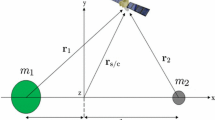Abstract
The periodic or quasi-periodic orbits around collinear Lagrange points present many properties that are advantageous for space missions. These Lagrange point orbits are exponentially unstable. On the basis of an analytical method, an orbit control strategy that is designed to eliminate the dominant unstable components of Lagrange point orbits is developed. The proposed strategy enables the derivation of the analytical expression of nonlinear control force. The control parameter of this strategy can be arbitrarily selected provided that the parameter is considerably lower than the negative eigenvalue of motion equations, and that the energy required keeps the same order of magnitude. The periodic or quasi-periodic orbit of controlled equations remains near the periodic or quasi-periodic orbit of uncontrolled equations.
Similar content being viewed by others
References
Dunham D W, Farquhar R W. Libration point missions, 1978–2002. In: Proceedings of the Conference of Libration Point Orbits and Applications. Singapore: Word Scientific, 2003. 45–67
David F, Karen R. Libration orbit mission design at L2: A MAP and NGST perspective. In: Proceedings of AAS/AIAA Astrodynamics Specialist Conference. Monterey, California: AIAA, 1998. AIAA 98-4469
Juillet J J, Collaudin B, Rideau P. The herschel/planck program—technical challenges for two science missions—the spacecraft. In: Proceedings of the 57th International Astronautical Congress. Valenica, Spain: Curran Associates, Inc., 2006. IAC-06-A3.1.2.
Farquhar R W. The Control and Use of Libration Point Satellites. Technical Report TR R346, NASA.1970
Breakwell J V, Kamel A A, Ratner M J. Station-keeping for a translunar communications station. Celest Mech, 1974, 10(3): 357–373
Farquhar R W, Muhonen D P, Newman C R, et al. Trajectories and orbital maneuvers for the first libration-point satellite. J Guid Control, 1980, 3(6): 549–554
Howell K C, Pernicka H J. Numerical determination of Lissajous trajectories in the restricted three-body problem. Celest Mech, 1988, 41: 107–124
Howell K C, Pernicka H J. Stationkeeping method for libration point trajectories. J Guid Control, 1993, 16(1): 151–159
Howell K C, Gordon S C. Orbit determination error analysis and a stationkeeping strategy for sun-earth L 1 libration point orbits. J Astronaut Sci, 1994, 42(2): 207–228
Keeter T M. Station-keeping strategies for libration point orbits: Target point and floquet mode approaches. Dissertation for the Master’s Degree. West Lafayette, Indiana: Purdue University, 1994
Gomez G, Howell K, Masdemont J, et al. Station keeping strategies for translunar libration point orbits. In: Proceedings of AAS/AIAA Astrodynamics Specialist Conference. Monterey, California: AIAA, 1998. AAS 98-168
Simo C, Gomez G, Llibre J, et al. Station keeping of a quasiperiodic halo orbit using invariant manifolds. In: Proceedings of the Second International Symposium on Spacecraft Flight Dynamics. Darmstadt: European Space Agency, 1986. 65–70
Simo C, Gomez G, Llibre J, et al. On the optimal station keeping control of halo orbits. Acta Astronaut, 1987, 15(6): 391–397
Hou X Y, Wang H H, Liu L. On station-keeping and control of the World Space Observatory of Ultraviolet. Chin J Astron Astrophys, 2006, 6(3): 372–378
Xu M, Xu S J. Stationkeeping strategy of Halo orbit in linear periodic control. Aerosp Control, 2008, 26(3): 13–18
BaoYin H X, McInnes C R. Solar sail halo orbits at the Sun-Earth artificial L-1 point. Celest Mech Dyn Astron, 2006, 94(2): 155–171
Gong S P, Li J F, BaoYin H X. Solar radiation pressure used for formation flying control around the Sun-Earth libration point. Appl Math Mech-Engl Ed, 2009, 30(8): 1009–1016
Gong S P, BaoYin H X, Li J F. Multi-satellite reconfiguration of formation around libration point. Trans Jpn Soc Aeronaut Space Sci, 2009, 51(174): 213–219
Lü J, Li J F, Lu Q S, et al. Periodic orbits based on geometric structure of center manifold around Lagrange points. Astrophys Space Sci, 2012, 340(1): 17–25
Author information
Authors and Affiliations
Corresponding author
Rights and permissions
About this article
Cite this article
Lü, J., Lu, Q. & Wang, Q. Orbit control strategy for Lagrange point orbits based on an analytical method. Sci. China Phys. Mech. Astron. 56, 830–839 (2013). https://doi.org/10.1007/s11433-013-5051-3
Received:
Accepted:
Published:
Issue Date:
DOI: https://doi.org/10.1007/s11433-013-5051-3




